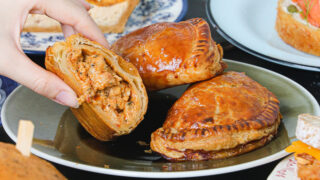![]() Craving a strong hit of caffeine in a toe-curling brew? A cup of local coffee at one of Singapore’s more than 3,000 kopitiams (coffee shops) could set you back as little as 80 cents, says VERNE MAREE – especially if it’s in a heartlands market or housing estate. At famous chains such as Killiney Kopitiam and Yakun Toast, it starts from $1.50.
Craving a strong hit of caffeine in a toe-curling brew? A cup of local coffee at one of Singapore’s more than 3,000 kopitiams (coffee shops) could set you back as little as 80 cents, says VERNE MAREE – especially if it’s in a heartlands market or housing estate. At famous chains such as Killiney Kopitiam and Yakun Toast, it starts from $1.50.
How it’s made
In traditional style, the beans are wok-roasted with sugar, margarine and sometimes pineapple skin and maize, to a dark black brown, then ground and brewed with a sock-like cotton strainer in watering can-sized pots.
Both Killiney Kopitiam and Yakun Toast were started by Hainanese immigrants; Killiney’s roots go back to the Killiney Road shop established in 1919, and Yakun’s to 1926. According to Killiney, its coffee is made from a blend of Columbian Arabica coffee beans and Indonesian Robusta coffee beans “to create an alluring aroma and mesmerising taste”.
We watched them make a kopi-C at Yakun Toast in Parkway Parade. After heating the cup by pouring hot water into and over it, they put in evaporated milk and sugar, pour in the coffee, top it up with a little hot water and serve it with a teaspoon on the side.
Wherever you go, thick white china cups are mandatory, with or without the traditional blue-and-white pattern. If you ask for tapau (“takeaway” in Hokkien), your coffee comes in a scarily carcinogenic polystyrene cup, or, even worse, a plastic bag.

What to eat
Standard breakfast fare is the Hainanese-Western half-boiled eggs, kaya toast and coffee set. You’re supposed to break your own very runny eggs into a bowl and season them to taste with soya sauce. Kaya is coconut jam made from coconut, eggs and sugar.
At the original Killiney Kopitiam outlet in Killiney Road, it’s mandatory for your server to slop approximately one quarter of your coffee into the saucer. We also enjoy the heart-stopping screech of orders being relayed from serving to kitchen staff – preparing the adrenals for the imminent jolt of caffeine, perhaps.
We tend to prefer the kaya toast at Yakun: light brown instead of soft white, each slice of bread is toasted, then split into two thin, crispy halves that are sandwiched with a spread of kaya and a couple of generous slabs of cold butter. That said, we’ve had our best-ever kopi and kaya toast at Good Morning Nanyang Café at Chinatown Point.
And for an East Coast hangover, you can’t beat the addictively spicy chicken curry at Killiney Kopitiam in Siglap. Along with a cup or two of whatever form of kopi takes your fancy, it’s guaranteed to set you to rights.

How to order
By default, a coffee or kopi (say ‘kaw-pee’) comes with condensed milk and sugar at the bottom of the cup. Or you can ask for:
Kopi: Black Coffee with condensed milk
Kopi Peng: Sweet black coffee with condensed milk and ice
Kopi O Siew Dai: Black coffee with less sugar
Kopi-O: Sweet black coffee
Kopi-Kosong: Unsweetened black coffee
Kopi Kosong Peng: Unsweetened black coffee with ice
Kopi-O Peng: Sweet black coffee with ice
Kopi Gah Dai: Black coffee with extra condensed milk
Kopi Po: A weaker coffee with condensed milk
Kopi Gau: Strong coffee with condensed milk
Kopi-C: Coffee with unsweetened evaporated milk (the C is for Carnation); but they’ll still add sugar
Kopi Ta Bao: To-go
To really sound like a local, order ‘kopi sua’ – two regular coffees.

Terminology:
O: Black with sugar
C: With evaporated milk and sugar instead of condensed milk
Kosong: No sugar or milk added
Gah Dai: Extra condensed milk
Xiu Dai: Less sugar
Po: Thinner coffee
Peng: Iced
Where to get good kopi and kaya toast:
- Good Morning Nanyang Cafe, 32 Maxwell Road
- Tong Ah Kopitiam, 25 Keong Siak Road
- Killiney Kopitiam, 67 Killiney Road
We hope you found this interesting; click here if you’d like to read more.
Champagne brunches reviewed just for you!
Guide to dim sum in Singapore





